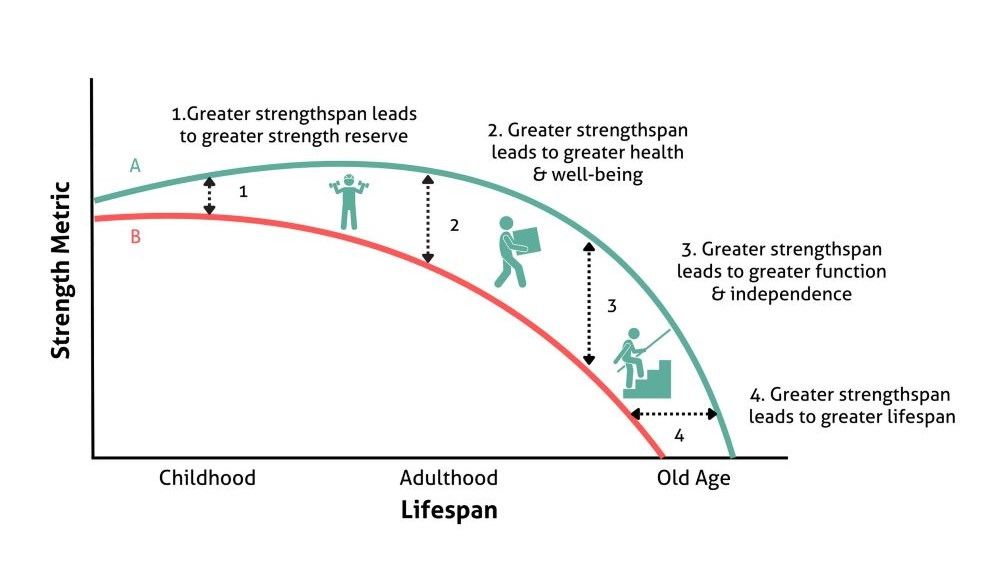Regular participation in muscle-strengthening activities is associated with observable health and fitness benefits. In addition to improving physical functioning and psychological well-being, a growing body of evidence links strength training with longevity. That is to say, engaging in strength-building activities throughout the life course can help adults live longer and live healthier. Instead of focusing solely on the concept of lifespan, which simply refers to the quantity of years lived, we should think about the construct of “strengthspan,” which emphasizes the quality of life in terms of physical strength and function. A greater strengthspan means an individual may not only live longer, but may also be able to perform everyday tasks independently and recreational activities proficiently as they age.
By definition, strengthspan refers to a quantitative metric of physical strength, such as grip strength or repetition maximum strength over a lifespan. This term not only recognizes the importance of building and maintaining a reserve of muscular strength early in life, but also includes the ability to function independently and move safely. The construct of strengthspan promotes the idea that maintaining physical strength is essential for maintaining mobility and building resilience against age-related declines in muscle function. While individual responses to strength training can vary, adults of any age can make meaningful improvements in strength and functional capacity with consistent participation in muscle-strengthening activities that are tailored to their needs and abilities. The figure illustrates life-course trajectories for hypothetical strengthspan curves for (A) optimal strength development, improved health and longer lifespan and (B) suboptimal strength development, poor health and shorter lifespan.
Unfortunately, the number of adults who regularly engage in muscle-strengthening activities is falling far short of expectations. Data from the National Health Interview Survey found that only about 7% of adults in the United States meet physical activity guidelines for muscle-strengthening activities. Consequently, too many adults are not building and maintaining a reserve of muscular strength that will enable them to stay active as they age. If health and exercise professionals aim to foster healthy aging, they must recognize the importance of expanding the strengthspan from the early years through the later years to reduce the rate and magnitude of decline in muscular strength. Without exercise interventions that include muscle-strengthening activities, the loss of muscle strength will accelerate, the ability to perform physical tasks will decline and the quality of life will decrease, further exacerbating feelings of inadequacy and isolation.
Social support: Encouragement from health coaches, exercise professionals and peers can boost motivation and exercising with others can make strength training more fun.
Talk to others: Health coaches and exercise professionals can discuss the importance of muscular strength with their clients and talk about appropriate starting weights, proper technique and safety precautions.
Regular motivation: Setting realistic goals and monitoring progress on workout logs or mobile apps can help to maintain interest and motivation, leading to the development of healthy habits.
Optimize attitudes: Introducing adults to muscle-strengthening activities in a supportive and nonjudgemental setting can help to overcome fears and misperceptions about strength-building activities while also helping individuals feel more comfortable and empowered to strength train.
Nurture ability: Improving your client’s knowledge and understanding of muscle-strengthening activities and encouraging them to exercise at a level that is consistent with their physical abilities can help to integrate strength-building exercises into their weekly routine.
Gentle persistence: A gentle approach with a gradual progression of sets, repetitions and exercises can lead to a more positive experience, making the strengthspan journey more enjoyable and fulfilling.
If you’re interested in working with the growing population of older adults and helping them gain strength, ward off muscle deterioration and reduce inactivity-related disease and cognitive decline, consider becoming an ACE Senior Fitness Specialist (worth 2.5 ACE CECs). This course will help you understand the unique psychological and physiological needs of senior clients and create truly personalized exercise programming.



